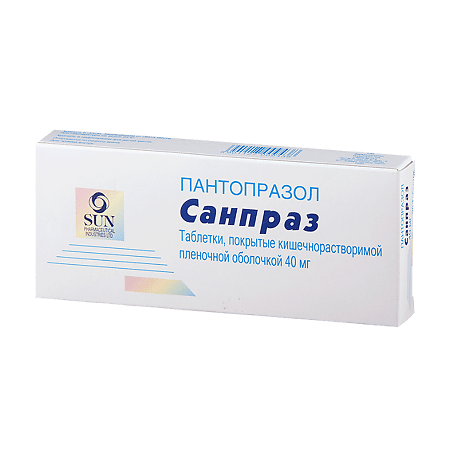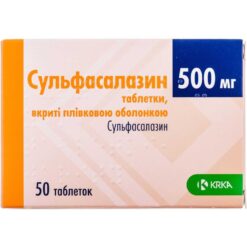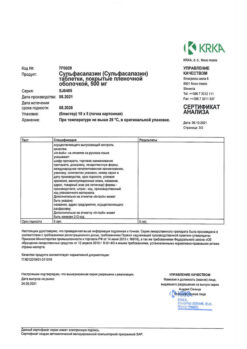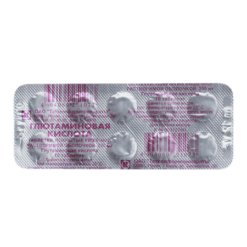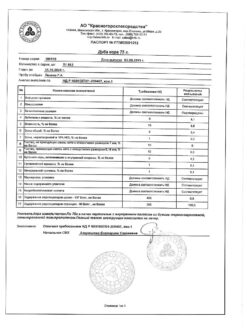No products in the cart.
Sanpras, 40 mg 30 pcs.
€21.41 €17.85
EAN: 8901127009438
SKU: 209831
Categories: Medicine, Stomach, intestines, liver, Ulcer and gastritis
Description
H+-K+-ATPase inhibitor. Sanpraz blocks the final stage of chlorohydric (hydrochloric) acid secretion, reduces the level of basal and stimulated (regardless of the type of irritant) chlorohydric (hydrochloric) acid secretion in the stomach.
In duodenal ulcer associated with Helicobacter pylori, decreased gastric secretion increases the sensitivity of the micro-organism to antibiotics.
Pharmacokinetics
Absorption
After oral administration pantoprazole is rapidly absorbed from the GI tract. Cmax is reached after 2.5 hours and is 2-3 mg/l, herewith Cmax value remains unchanged after multiple administration. Bioavailability is 65-77%.
Elimination
T1/2 is about 1 hour.
Indications
Indications
peptic ulcer of the stomach or duodenum in the acute phase;
erosive gastritis (including those associated with Helicobacter pylori);
erosive and ulcerative lesions of the stomach and duodenum associated with taking NSAIDs;
reflux esophagitis.
Pharmacological effect
Pharmacological effect
H+-K+-ATPase inhibitor. Sanpraz blocks the final stage of the secretion of hydrochloric (hydrochloric) acid, reduces the level of basal and stimulated (regardless of the type of stimulus) secretion of hydrochloric (hydrochloric) acid in the stomach.
In case of duodenal ulcer associated with Helicobacter pylori, a decrease in gastric secretion increases the sensitivity of the microorganism to antibiotics.
Pharmacokinetics
Suction
After taking the drug orally, pantoprazole is quickly absorbed from the gastrointestinal tract. Cmax is reached after 2.5 hours and is 2-3 mg/l, while the Cmax value remains unchanged with repeated doses. Bioavailability 65-77%.
Removal
T1/2 – about 1 hour.
Special instructions
Special instructions
The use of pantoprazole for dyspepsia of neurogenic origin is not effective.
In the presence of any of the warning signs (eg, significant unintentional weight loss, recurrent vomiting, dysphagia, anemia, or melena) and if a gastric ulcer is suspected or present, the possibility of malignancy should be excluded, because Treatment with pantoprazole may reduce symptoms and delay correct diagnosis. If symptoms persist despite adequate treatment, further evaluation should be performed.
Before and after treatment, endoscopic monitoring is required to exclude the possibility of malignant diseases of the stomach or esophagus, since treatment can mask symptoms and delay correct diagnosis.
Use in pediatrics
There is not enough data on the use of the drug in children under 18 years of age.
Impact on the ability to drive vehicles and operate machinery
The use of the drug does not affect the patient’s ability to perform work that requires increased attention and speed of psychomotor reactions.
Active ingredient
Active ingredient
Pantoprazole
Composition
Composition
1 tablet contains:
Active substance:
pantoprazole 40 mg;
Excipients:
magnesium oxide – 18 mg,
calcium carbonate – 81.4 mg,
crospovidone – 35 mg,
sodium lauryl sulfate – 5 mg,
calcium stearate – 3 mg,
colloidal silicon dioxide – 5 mg;
Shell composition:
copolymer of methacrylic acid and ethyl acrylate (1:1) – 11 mg, triethyl citrate – 1.1 mg, copovidone – 7 mg, talc – 10.7 mg, titanium dioxide (E171) – 0.8 mg, iron oxide yellow (E172) – 0.2 mg, macrogol 6000 – 0.35 mg.
Pregnancy
Pregnancy
Experience with the use of the drug during pregnancy and lactation is limited. The drug can be used during pregnancy only if the benefit to the mother outweighs the possible risk to the fetus.
There is no data on the excretion of pantoprazole in breast milk. Breastfeeding should be stopped while taking the drug.
In experimental studies of reproductive function, minor embryotoxicity was noted at doses exceeding 5 mg/kg.
Contraindications
Contraindications
dyspepsia of neurotic origin;
malignant diseases of the gastrointestinal tract;
children’s age (due to the lack of data on the use of the drug in pediatric practice);
hypersensitivity to pantoprazole.
The drug is prescribed with caution for liver failure.
Side Effects
Side Effects
When taking Sanpraz in accordance with the indications and in recommended doses, side effects occur extremely rarely.
From the side of the central nervous system: sometimes – headache; rarely – depression, hallucinations (especially in predisposed patients), disorientation and confusion; in isolated cases – dizziness or blurred vision.
From the digestive system: sometimes – pain in the upper abdomen, diarrhea, constipation, flatulence; rarely – nausea, vomiting, dry mouth; very rarely – hepatocellular failure, leading to jaundice with or without liver failure, increased activity of liver enzymes (transaminases, glutamyl transpeptidase).
From the musculoskeletal system: rarely – arthralgia; in isolated cases – myalgia.
From the hematopoietic system: very rarely – leukopenia, thrombocytopenia.
Allergic reactions: very rarely – anaphylactic reactions, including anaphylactic shock, urticaria, angioedema.
Interaction
Interaction
The simultaneous use of Sanpraz may reduce the absorption of drugs whose bioavailability depends on the pH of the stomach (including ketoconazole, iron salts, ritonavir).
When Sanpraz is used together with atazanavir, plasma concentrations of atazanavir decrease and its therapeutic effect decreases.
When performing specific tests of Sanpraz with drugs such as digoxin, nifedipine, metoprolol, amoxicillin, clarithromycin, oral contraceptives (levonorgestrel/ethinyl estradiol), diclofenac, phenazone, naproxen, piroxicam, glibenclamide, levothyroxine sodium, diazepam, carbamazepine, phenytoin, cyclosporine, tacrolimus, cisapride, midazolam, metronidazole, theophylline, caffeine, ethanol, no clinically significant interactions were found.
According to post-marketing data, when the drug is taken together with warfarin, the prothrombin time increases, which can lead to bleeding, even death. It is recommended to determine prothrombin time.
Storage conditions
Storage conditions
In a dry place, protected from light, at a temperature not exceeding 25 °C
Shelf life
Shelf life
3 years
Manufacturer
Manufacturer
Sun Pharmaceutical Industries Ltd, India
Additional information
| Shelf life | 3 years |
|---|---|
| Conditions of storage | In a dry, light-protected place at a temperature not exceeding 25 °C |
| Manufacturer | Sun Pharmaceutical Industries Ltd, India |
| Medication form | enteric soluble tablets |
| Brand | Sun Pharmaceutical Industries Ltd |
Related products
Buy Sanpras, 40 mg 30 pcs. with delivery to USA, UK, Europe and over 120 other countries.

